Published February 2020
Spring foliage colors and color patterns are among my favorite Epimedium traits. Many, but not all Epimedium species and varieties, exhibit these characteristics. The colors reveal themselves only on the soft new growth, enhanced by cool spring temperatures. These colors are thought to be an evolutionary adaptation to protect the tender new leaflets from strong sunlight. Some evidence also indicates that they discourage chewing insects. Whatever the reason, this colorful pop of new foliage is a beautiful addition to the spring shade garden.

Spring foliage color can range from near black to deep purple, mahogany, tan, cranberry, rose red, hot pink, brilliant orange and limey green. Each variety and clone has its own unique color and pattern in spring. As the weather warms and the leaves mature, most colors turn to green, except for a few variegated varieties. I find that the “ephemeral-ness” of this quality makes it all the more delightful.
The colors and color patterns of spring foliage in Epimediums are not static, but change from day to day. Some Epimediums even produce a second flush of growth with its attendant spring color. This happens just as the blossoms fade and the first foliage flush greens up. The secondary growth flush bears the same color as that of the earlier spring flush, but the color is more diffuse. A long, cool spring delays the maturation of the leaves, allowing the plants to hold their spring foliage color even longer. These colorful displays sometimes last into the early weeks of June here in Massachusetts.
How Light Affects Color:

Epimedium koreanum ‘Harold Epstein’ leaves from the same plant growing under different levels of direct sun. Left (shade- no direct sunlight) to right (with 2-3 hours of direct sunlight per day).Although Epimediums are considered shade plants, the quality of that shade makes a difference. The amount of sunlight the plants receive affects not only their rate of growth, but also their floriferousness, and the intensity of their spring foliage color. Below are leaves from a grouping of Epimedium koreanum ‘Harold Epstein’ planted under a large Dawn Redwood tree. The leaves to the left grow in the deepest shade. Each leaflet grows larger and remains mostly green with only a thin red border. Those growing in 2-3 hours of sun on the right, are smaller and have more intense spring color. Too much sun, especially under dry conditions, can cause foliar burn. This damage is unsightly, but will not kill the plant. If this happens, transplant the affected plant to an area where it will receive more shade and moisture.
The key in siting your Epimediums for their best possible performance, is to give them as much light as they can withstand in your garden, without causing foliar damage. High shade, with perhaps a couple of hours of early morning or late afternoon sun is ideal in most regions.
Colors and Patterns:
Below I’ve highlighted a few lesser known Epimedium varieties that exhibit good spring foliage color. Some of these varieties appear in the Collections offered on this website. These examples show some of the range of spring foliage color and color patterns expressed in the genus.
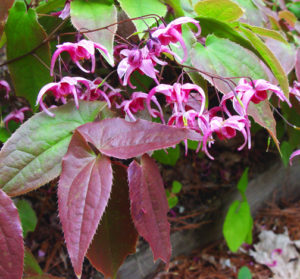
Epimedium ‘Hot Lips’ was introduced by Diana Reeck of the former Collector’s Nursery. The name refers to the color of the flowers, but the color of the foliage is equally as beautiful. From deep red-pink to hot pink, it provides an attractive tinge to the outermost, large, semi-evergreen leaves of this substantial Epimedium (which grows up to 20″ tall in my Massachusetts garden in a bit of sun)

Another eye-catching Diana Reeck introduction, Epimedium x youngianum ‘Starlet’ explodes in a riot of lavender and white bloom. It is an early and long-blooming, medium-sized Epimedium, reaching 12″ high after its second growth flush. The distinct, dark border exhibited on the leaflets is a familiar pattern on many hybrids that have Epimedium grandiflorum var. higoense in their makeup. This border color varies from dark cranberry red as in Epimedium grandiflorum ‘Spring Wedding’ or ‘Swallowtail’, to the deep shade of purple that you see here.
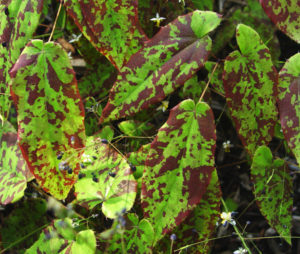
Several evergreen Epimedium species native to China exhibit this dark mottling or “flecking” on the tender new spring growth. Epimedium myrianthum ‘Mottled Madness’ is a particularly good example. The flowers are tiny– barely visible upon close observation, but the spring foliage is remarkable. Epimedium fargesii is another example, where the dark spring mottling sometimes returns as a ghostly shadow again in the cool of the fall.
On most Epimediums, the foliage color is darkest when the plant first emerges from the ground; often before the blossoms have opened. As the days go by, the leaves expand, the flowers open, more chlorophyll is produced and the foliage colors changes to green. Observe the same plant every day during this progression, and you will find that each day the scene will change.
Some Epimediums such as Epimedium x versicolor ‘Cupreum’ shown here, exhibit red spring foliage color on all but the green leaf veins, creating an eyecatching pattern. Epimedium x rubrum and two other Epimedium x versicolor hybrids ‘Sulphureum’ and ‘Versicolor’ also express this color pattern in spring.
A few hybrids show a combination of patterns, like Epimedium ‘Serendipity’ which pairs its dark edging with irregular dark splotches on the new spring green foliage.
My advice when choosing Epimediums is to look beyond the flowers– to the leaves, for a beautiful and changing color progression that welcomes back the spring.
Karen Perkins
Garden Vision Epimediums